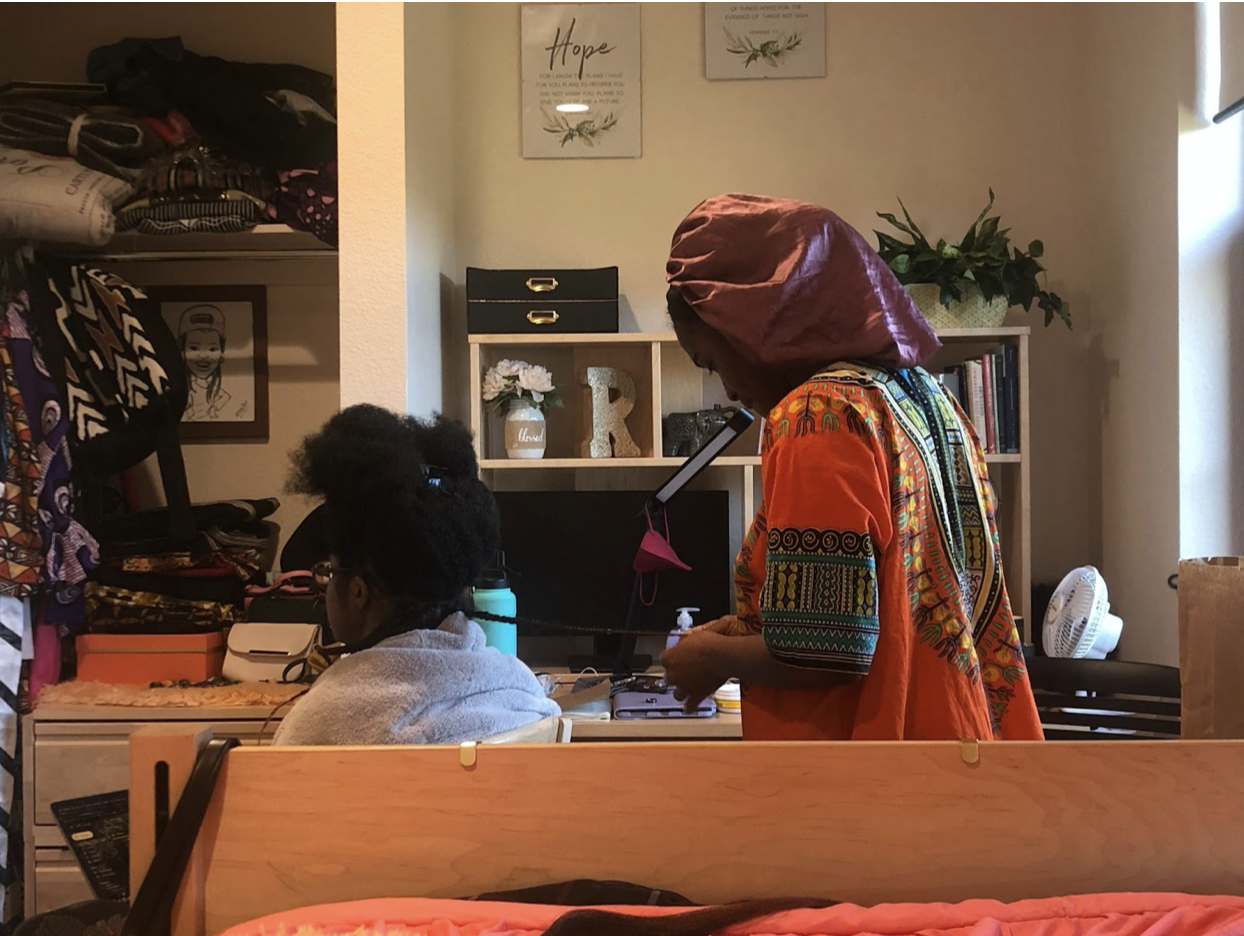I sit on the bed, watching as my friend Roxane braids Janae’s hair. In fascination, I realize braiding is such an underrated cultural process. Many think it’s just like any other hairstyle; they are unaware of the rich cultural phenomenon that it truly is and the interpersonal connections that braiding can produce.
“Your hair is so long” Roxane says as she parts Janae’s hair. It’s coarse and long, yet voluminous and cloudy, a radiant afro that comes as quite the surprise given that it is usually hidden under a beanie. We all wonder why she doesn’t wear it out more.
As Roxane gets the natural hair ready for braiding, we talk about an array of things. We touch upon various topics, from Google vs. Mozilla browsers to internet security; from China’s increasing presence in Africa to the consequences of its global dominance; from African-American/African relations here at Stanford to the movies Tenet and Soul; and, of course, the topic of hair. We talk about the hair at hand, braiding hair, different styles and the whole process of it. The conversation is very meta, very soothing and very comforting. The whole situation reminds me of home, and, yet, it’s also completely new territory.
Roxane sprays the hair, tying it and smiling at her progress.
She doesn’t charge for her work. “I am doing it for the experience,” she remarks in her Burkinabé accent. She looks at Janae’s hair in awe. “She has so much hair, it’s so crazy,” Roxane notes as she parts and clips the hair. “I’m so happy my mom made me get extra packs of clips.”
Soon, the parting is done and it’s time to get ready for installation — the actual braiding. Roxane still has to prep the extensions though.
“Quatre, cinq …” she counts the unbraided extensions in French, her second of five languages.
And the conversation continues:
Over the years, I can understand why people enjoy fantasy. It removes you from how reality is presented now. Different settings might intersect with realistic settings, different fantasy settings have the same problems that we have but in different ways … because it gives analogies to real world conflicts … but I really prefer how reality and sci-fi can be shifted and what-not on a cosmic level. What it means to be an individual, have consciousness and look beyond the self…
Janae continues her monologue. Meanwhile, Roxane excitedly eyes the hair, putting a towel on Janae’s back, followed by spraying, combing and prepping.
Roxane decides to contribute to the conversation. “I see what you mean, and personally, I believe….” and all of a sudden the conversation dives into religion and its intersection with sci-fi portrayals. Oops. We’ve now gone there.
And the conversations go on and on. They wind and turn and morph as do many others. And this process happens again and again and again; we bond as Roxane begins to braid.
She grabs the first handful of hair, figuring out how best to knot it at the root of the head. She pushes the head forward and now, on her tippy toes, lips pursed in concentration, nimbly roots the braid and integrates it with the hair. Once the hardest part is reached, she quickly flies down the rest of the ombre braid. One done. She had said 40 total. And the conversation has only begun. She moves onto the next braid, rubbing oil, brushing the hair out and then adding the extension.
“I do think there are forces outside of our imagination. But would they have consciousness in the same way that we do?”
The conversations never cease to blow my mind.
“I think I will want you to sit here.” Roxane beckons Janae over to a smaller stool than the tall chair Janae had been sitting at. Janae gets up and sits on the lower chair, shifting so that Roxane can have a better angle for braiding the hair. “Okay beautiful!” Roxane says as she bends her head and begins the next braid.
As a student, Roxane still has her own things to do. She hops on a Zoom call, turns the camera off and resumes braiding. Janae orders Caribbean food from “Back A Yard.”
“There is volume, there is length. Ahhh. It’s not ahhh it’s AHHHHH,” Roxane says, gesturing at Janae’s cloud of hair.
When you have hours and hours of braiding to do, so much conversation awaits. We start a fascinating discussion about “Blackness.” What’s interesting is that we are from different backgrounds: I am first-gen Sierra-Leonean American, Roxane was born and raised in Burkina Faso and Janae is African-American. There are so many ways to be “Black,” and each of our perspectives bring incredible nuance into the room and the conversations within it.
I go downstairs to pick up the Back A Yard. As we feast on Caribbean food — tasty veggie and beef patties, curried goat, plantains and jerk tofu among other delicious things — we hear funny stories from Roxane about chickens in some yard and comment on the lack of animal life in fast-paced cities. “One day my dad was sleeping and the rooster woke him up…” she starts. I soon hear another anecdote about pigs walking in the middle of some road.
As I continue to enjoy the food, conversation and braiding, I feel as if we don’t share enough with others how cool this process is. It’s a cultural pillar that has the power to unite people, whether they be from the same family or from different backgrounds. I wonder, is our conversation a result of Stanford’s intellectual culture combined with the African/African-American culture of warmth, personhood and sense of community? Or is it just a byproduct of sitting down for long periods of time to do hair? Either way, it’s an enjoyable experience. Indeed, I enjoy these braided conversations and can’t wait to interweave myself into many, many more.
